Chapter 1: Looking Back to Move Forward
‘Actionable Learning’- that’s a word that gets thrown around a lot in Agile circle. The continuous improvement ethos is based on finding effective ways to test and improve every aspect of a team’s performance. But we all know that’s easier said than done. And what often gets forgotten is the discipline of learning how to learn.
That’s where retrospectives come in. They help teams develop the skills required to learn, adapt and improve. Retrospectives are a crucial part of workplace projects because they provide a structured way for teams to reflect on their performance and drive their own methods to do something about it. It aims to get teams to learn from their mistakes, build on their successes, and continuously improve their processes.
There is no doubt that retrospectives are the key to innovation, creativity and better team communication and collaboration. In short, if you want your team to constantly learn and improve, finding the right way to retro is key.
The principle of continuous improvement
Agile continuous improvement comes from the Japanese word Kaizen, which translates into “change for the better.” This method seeks to make the process and overall work leaner by spotting areas of opportunity.
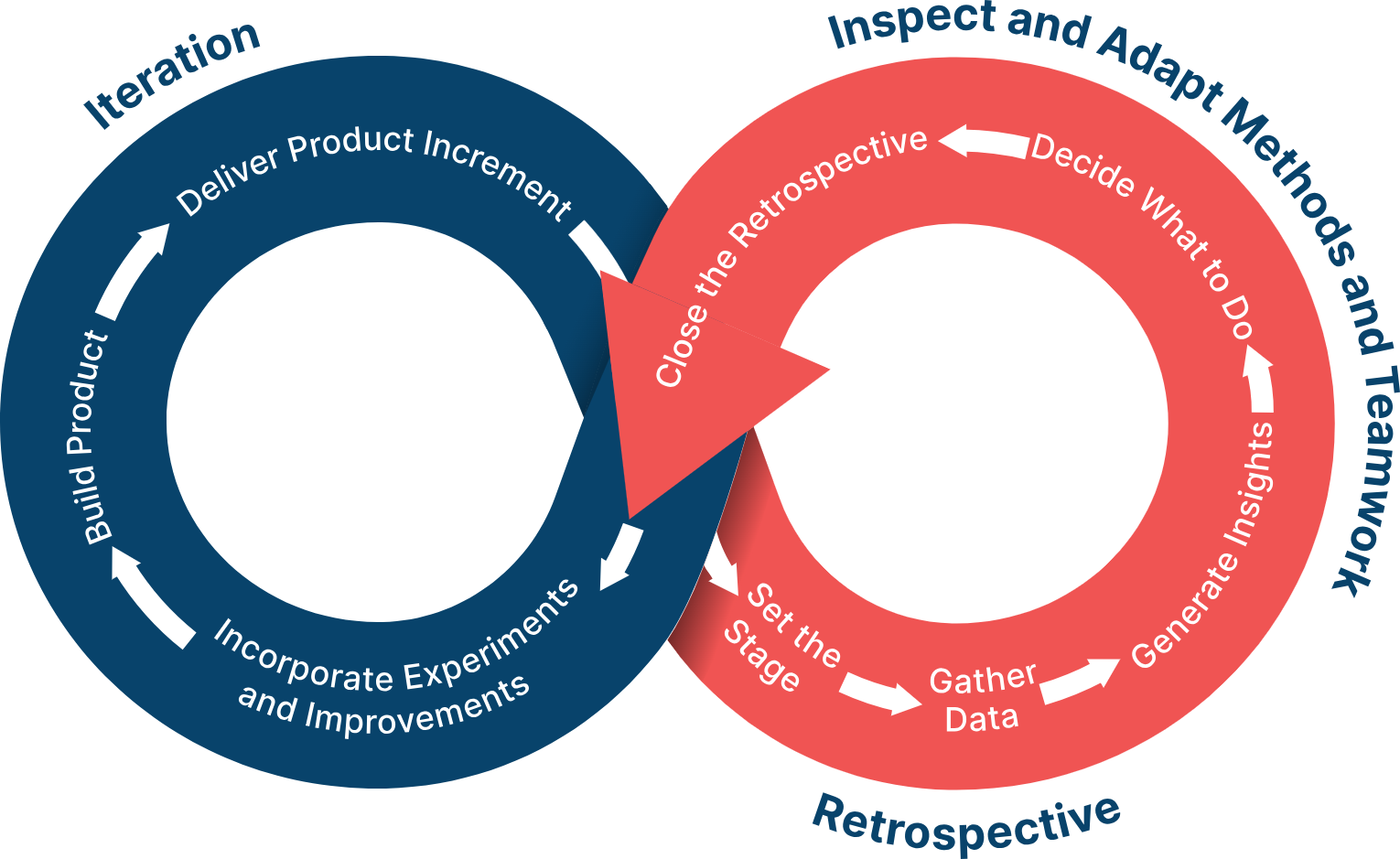
But first, a brief history
Retrospectives have its origins in the 1940s. They were first used in the US Army Air Force, after the conclusion of battle operations, and were called “after-action reviews."(AARs). And while today’s retros may not have such life-or-death consequences, the basic idea still stands. Retrospectives aim to reflect on past experiences and identify ways to improve future performance. By looking back on what went well and what didn’t, teams can learn from their mistakes, build on their successes, and find a way to win on the business battlefield.
So, why should you retro?

Focuses on why things happened
Retrospectives allow teams to delve into the reasons behind their successes or failures. By understanding the underlying factors that contributed to certain outcomes, teams can make informed decisions on how to improve and avoid similar pitfalls in the future.
Compares intended results with what was actually accomplished
One of the main objectives of a retrospective is to compare the team’s intended goals or targets with what was actually achieved. This evaluation helps identify any gaps or misalignments between expectations and outcomes, enabling the team to make necessary adjustments.
Encourages participation
Retrospectives emphasize the importance of involving every team member in the reflection process. By encouraging active participation from all team members, different perspectives and insights can be shared, leading to a more comprehensive understanding of the team’s performance and potential areas for improvement.
Emphasizes trust and the value of feedback
Trust and open communication are essential components of a successful retrospective. Creating a safe environment where team members feel comfortable sharing their thoughts and providing feedback is crucial. Constructive feedback allows the team to address issues, make changes, and foster a culture of continuous improvement.
By reflecting on past experiences, teams can identify opportunities for experimentation and exploration, which can lead to new ideas and approaches. Overall, conducting retrospectives regularly can help teams to continuously learn, improve, and grow.
Retrospectives are for everyone
It’s easy to slot retrospectives as an activity that only product or ’tech teams’ take part in, but the same principles and benefits of retrospectives apply to all kinds of teams, whether they are in sales, marketing, customer support, or any other department within an organization. Every team can benefit from reflecting on their work and finding ways to improve their processes.
For marketing teams, retrospectives enable a review of past campaigns and initiatives, analyzing their effectiveness, and identifying strategies for future success. It helps them refine their targeting, messaging, and marketing channels, leading to more impactful campaigns and increased customer engagement.
Customer service teams can utilize retrospectives to examine customer interactions, identify common pain points, and develop solutions to enhance customer satisfaction. By analyzing past cases, they can improve response times, streamline processes, and implement training programs to deliver better service.
In creative agencies, retrospectives provide a platform for designers, writers, and artists to share their experiences, learn from each other, and enhance their creative processes. They can evaluate the effectiveness of their designs, explore new techniques, and foster a collaborative environment that sparks innovation.

Construction teams can review previous projects to identify bottlenecks, optimize resource allocation, and enhance safety measures. Event planning teams can assess past events, gather attendee feedback, and refine their event management strategies for future occasions.
These sessions enable team members to voice their opinions, contribute ideas, and collectively solve problems, resulting in increased productivity and overall team success.
Retrospectives are NOT postmortems
It’s essential to differentiate retrospectives from postmortems. While both involve reviewing past events, retrospectives focus on continuous improvement and learning, whereas postmortems typically focus on analyzing what went wrong after a project or endeavor has concluded. Retrospectives provide an opportunity to celebrate successes, address challenges, and make ongoing improvements, whereas postmortems tend to be more focused on lessons learned.
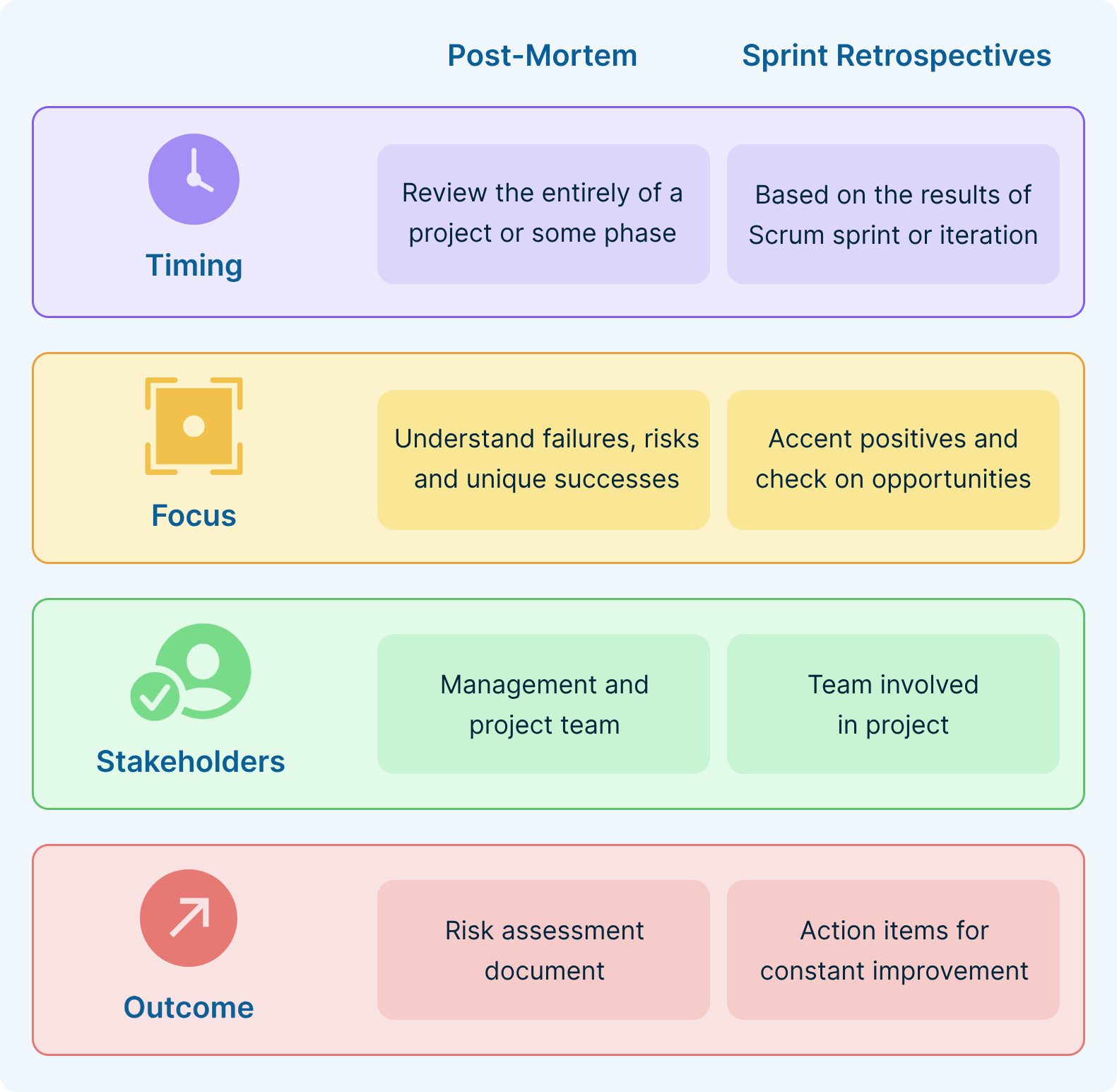
Chapter 2: Kicking it Off
Deciding to run retrospectives is just the start. Now you need to figure out a way for them to be engaging and useful for the whole team. Many times teams go into a retrospective meeting asking the question, “So what should we try and improve?” only to get long, awkward silences in response. But don’t worry, you’re not alone! Mastering the art of retrospectives can be a challenge, here are some ideas to help your team really get into it.
The prime directive
Before you can truly harness the benefits of retrospectives, it is essential to establish the right culture within the team. The Prime Directive is a guiding principle that sets the tone for retrospectives and creates a safe and open environment for team members to share their thoughts, experiences, and perspectives. It acts as a reminder and a working hypothesis that shapes the way individuals interact and collaborate during the retrospective process.
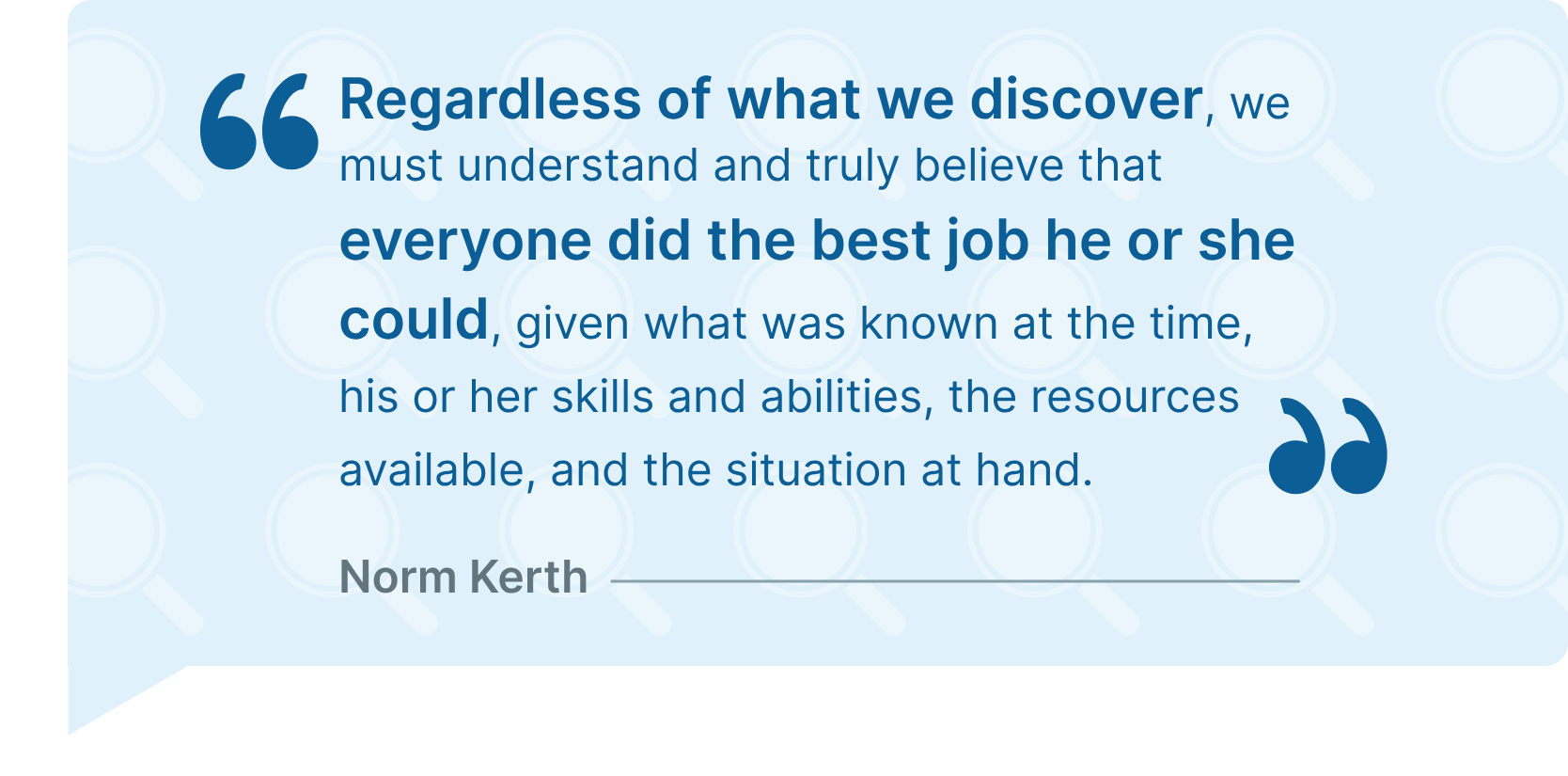
When the Prime Directive is applied during retrospectives, it encourages individuals to reflect on their actions, decisions, and contributions without self-criticism or defensiveness. It shifts the focus from blaming individuals to examining the system, processes, and circumstances that influenced outcomes. This mindset allows for a deeper understanding of the factors that contributed to both positive and negative outcomes, paving the way for meaningful discussions and actionable insights
The questions
To kick off a successful retrospective, it is crucial to set the stage properly. This involves creating an environment that encourages open and honest communication, reflection, and collaboration. By addressing the following questions, teams can establish a solid foundation for their retrospectives:
Questions to ask in a retrospective
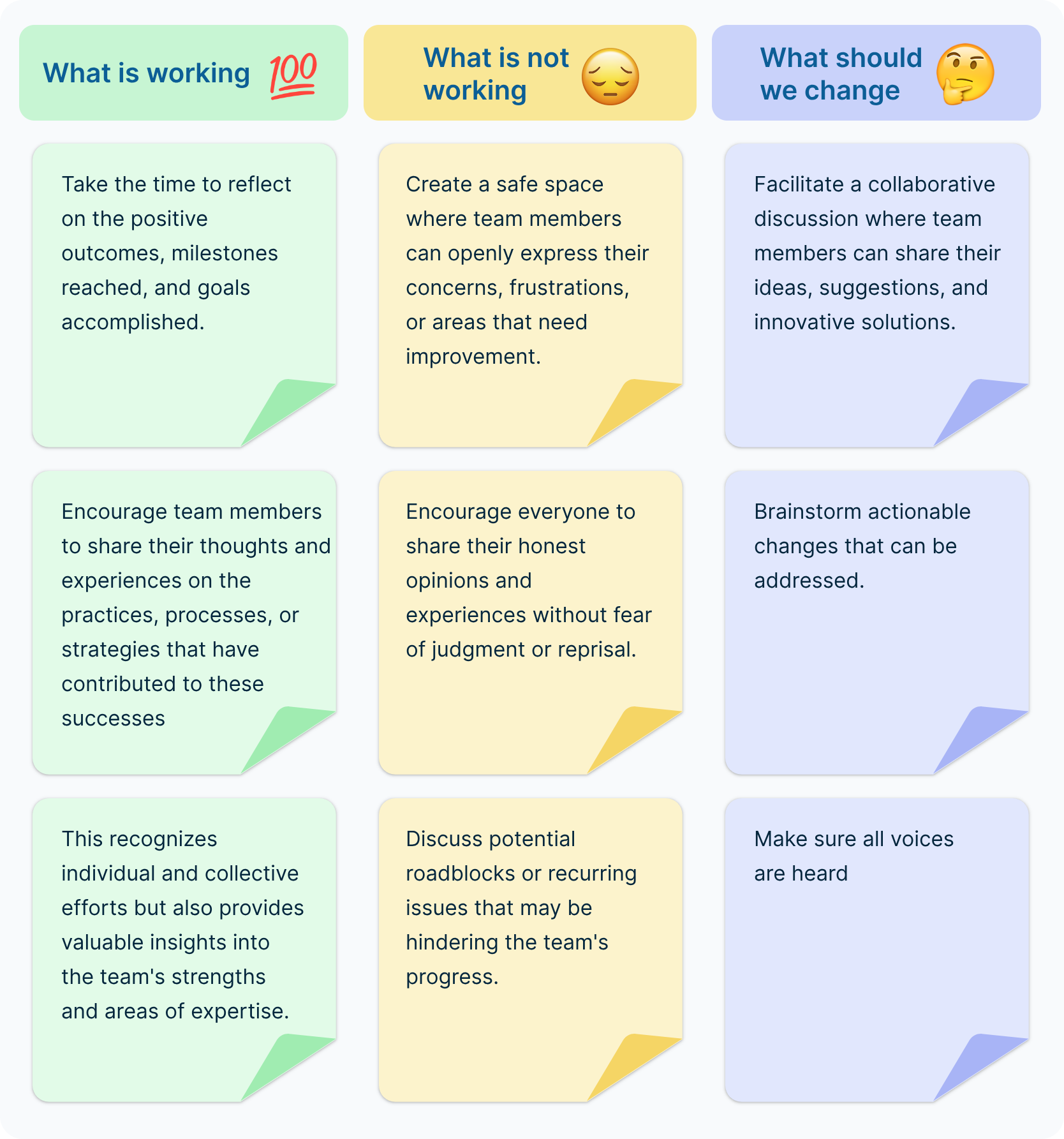
An Example of a Retro Board
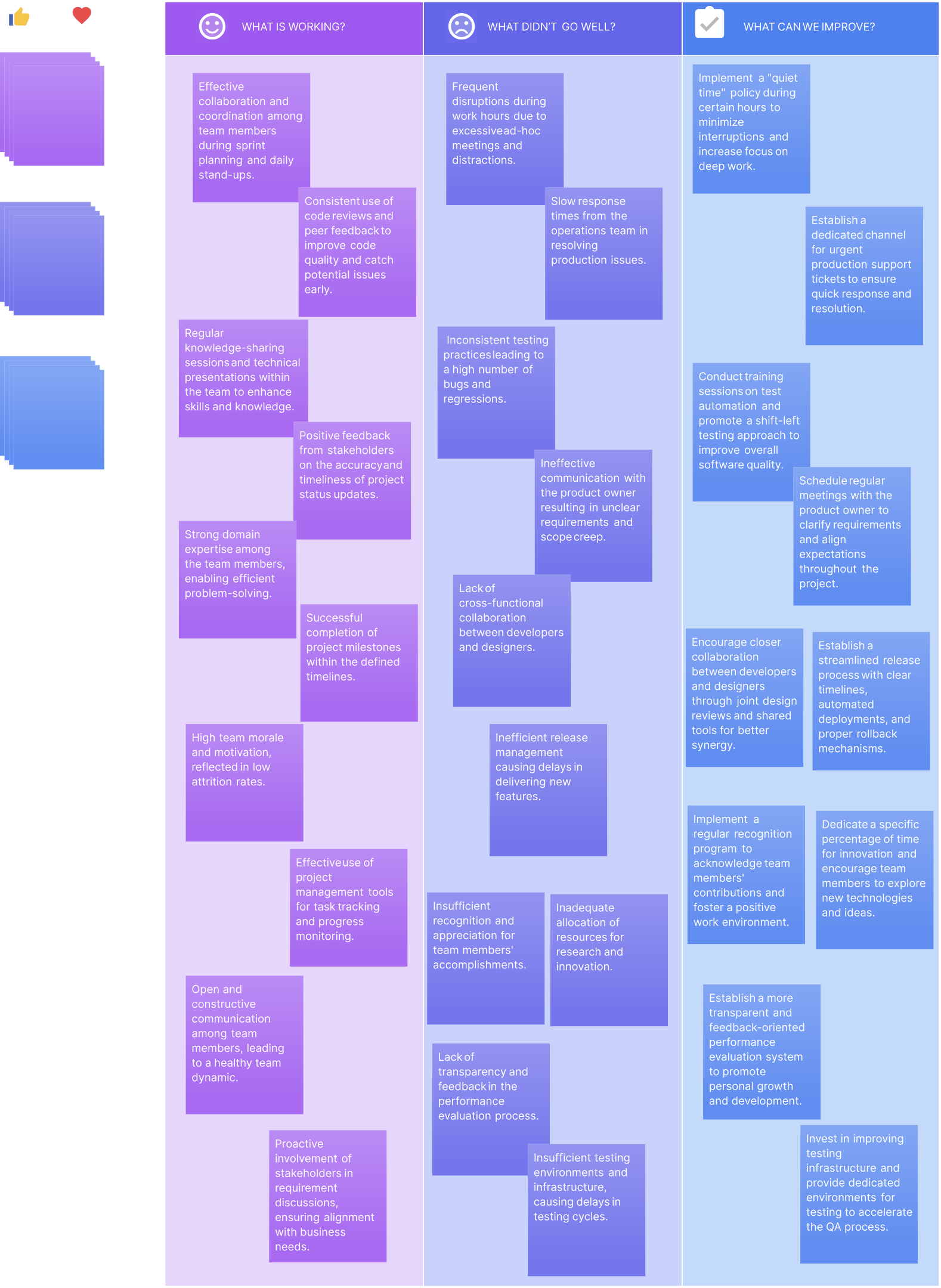
The people
The success of a retrospective heavily relies on the active participation and diverse perspectives of the right individuals.
Who should participate?
Identify the key stakeholders and team members who are directly involved in the project or process being retrospected. It is essential to have representation from different roles, departments, or levels of the organization to gain a holistic view of the team’s performance and dynamics.
Include individuals who have firsthand knowledge and experience related to the retrospective topic. This ensures that the discussions are grounded in practical insights and enables the team to make informed decisions.
Using a facilitator (Scrum Master)
Consider designating a facilitator for the retrospective, such as a Scrum Master or an experienced team member. The facilitator plays a crucial role in guiding the retrospective process, maintaining a positive and constructive atmosphere, and ensuring that all participants have an equal opportunity to contribute.
The facilitator should possess strong communication and facilitation skills, actively listen to different perspectives, and encourage active participation from all team members. An impartial and neutral facilitator allows the team to freely express their thoughts and ideas.

The format
There are various retrospective formats available that facilitate meaningful discussions and insights. Some popular formats include
Classic retrospective: This format involves reflecting on what went well, what didn’t go well, and what actions can be taken for improvement.
STAR retrospective: STAR stands for Stop, Continue, Add, and Remove. This format focuses on identifying actions to stop, continue, add, or remove from the team’s practices or processes.
Plus/Delta retrospective: This format involves listing the positive aspects (plus) and areas for improvement (delta) and discussing actionable steps for change.
5 whys retrospective: The team digs deep into the root causes of problems by repeatedly asking “why” until they reach the underlying issues.
Sailboat retrospective: The team visualizes their journey as a sailboat, identifying the anchors (things holding them back) and the wind (things propelling them forward) to guide their improvements.
Making sure things are actionable
One of the key objectives of a retrospective is to generate actionable outcomes that lead to real change and continuous improvement. To ensure this, it is important to:
Discuss specific actions
During the retrospective, encourage the team to generate specific, concrete actions that address the identified areas for improvement. Avoid vague or general statements and focus on actionable steps that can be implemented.
Prioritize and assign ownership
Once the actions are identified, prioritize them based on urgency and impact. Assign ownership to each action item to ensure accountability and follow-through. Clearly define the responsible parties and set realistic deadlines for completion.
Track progress
Regularly review and track the progress of the agreed-upon actions in subsequent retrospectives. Celebrate the achievements and adjust the approach if necessary. By tracking progress, the team can assess the effectiveness of the changes made and make further adjustments as needed.
By setting the stage effectively, assembling the right people, establishing the right process, and ensuring actionable outcomes, teams can maximize the value gained from retrospectives. In the following chapters, we will delve deeper into specific retrospective formats and techniques that can further enhance the retrospective experience and drive continuous improvement.
Chapter 3: Running the Retro
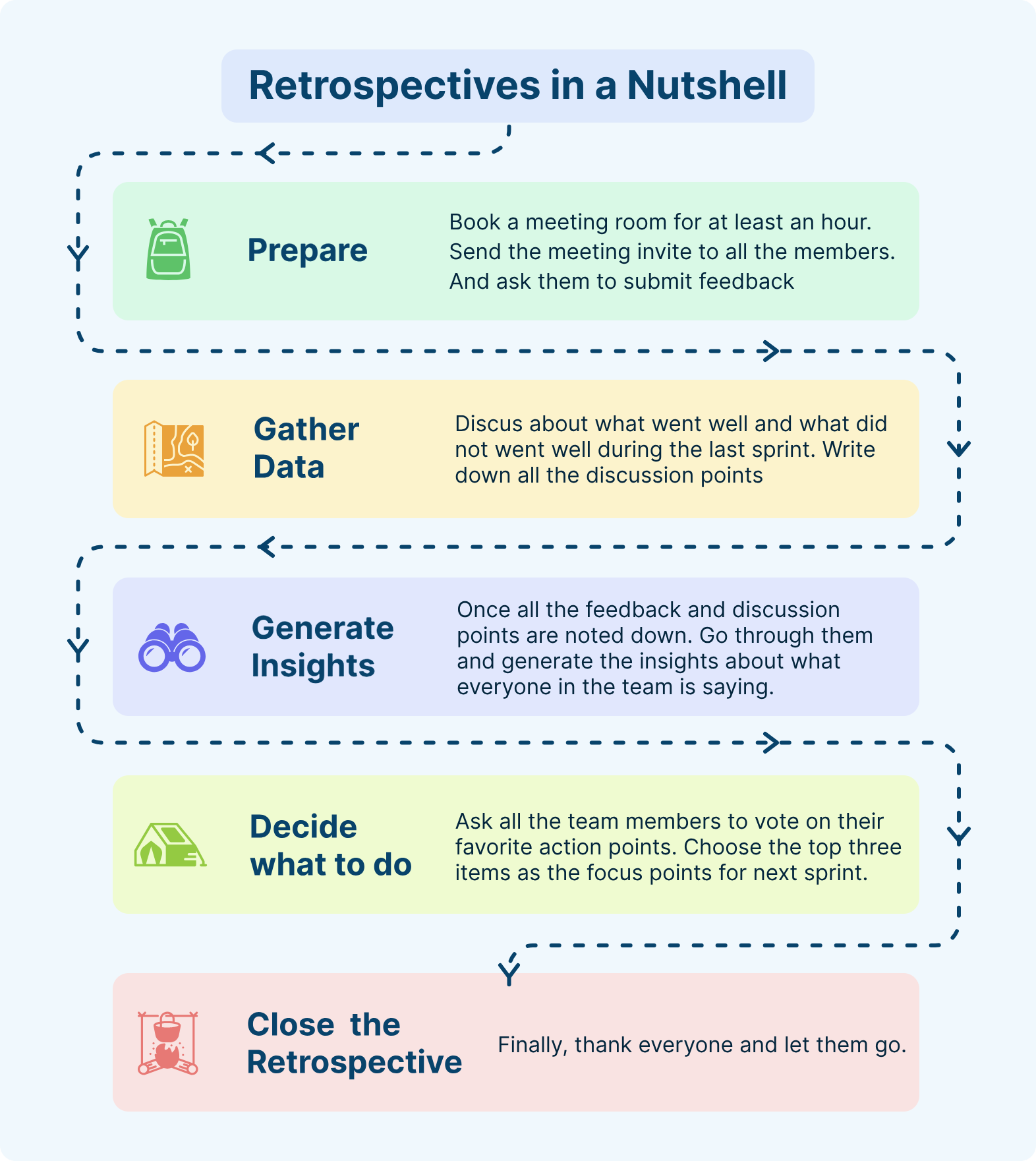
Retrospectives have the potential to be a powerful tool for driving continuous improvement and team collaboration. However, we’ve all been at poorly run retrospectives that can feel more like a chore rather than an opportunity for growth. If your team has grown disillusioned by retrospectives, It’s likely because the retrospectives you’ve conducted so far have fallen short of their potential.
In this chapter, we will explore how to kick off a retrospective in a way that captures your team’s attention, ignites their passion for improvement, and sets the stage for a productive and impactful discussion.
But before we dive into the nitty-gritty of running retrospectives, let’s address a common misconception: teams don’t care about retrospectives. If given the opportunity to magically solve their problems, most teams would jump at the chance. The key is to transform retrospectives into a powerful vehicle for effecting change, where the team takes ownership of their challenges and works together to overcome them.
Retrospectives are not about dwelling on past failures or pointing fingers; they are about empowering teams to identify areas for improvement and take action.
Phase 1: Setting the stage
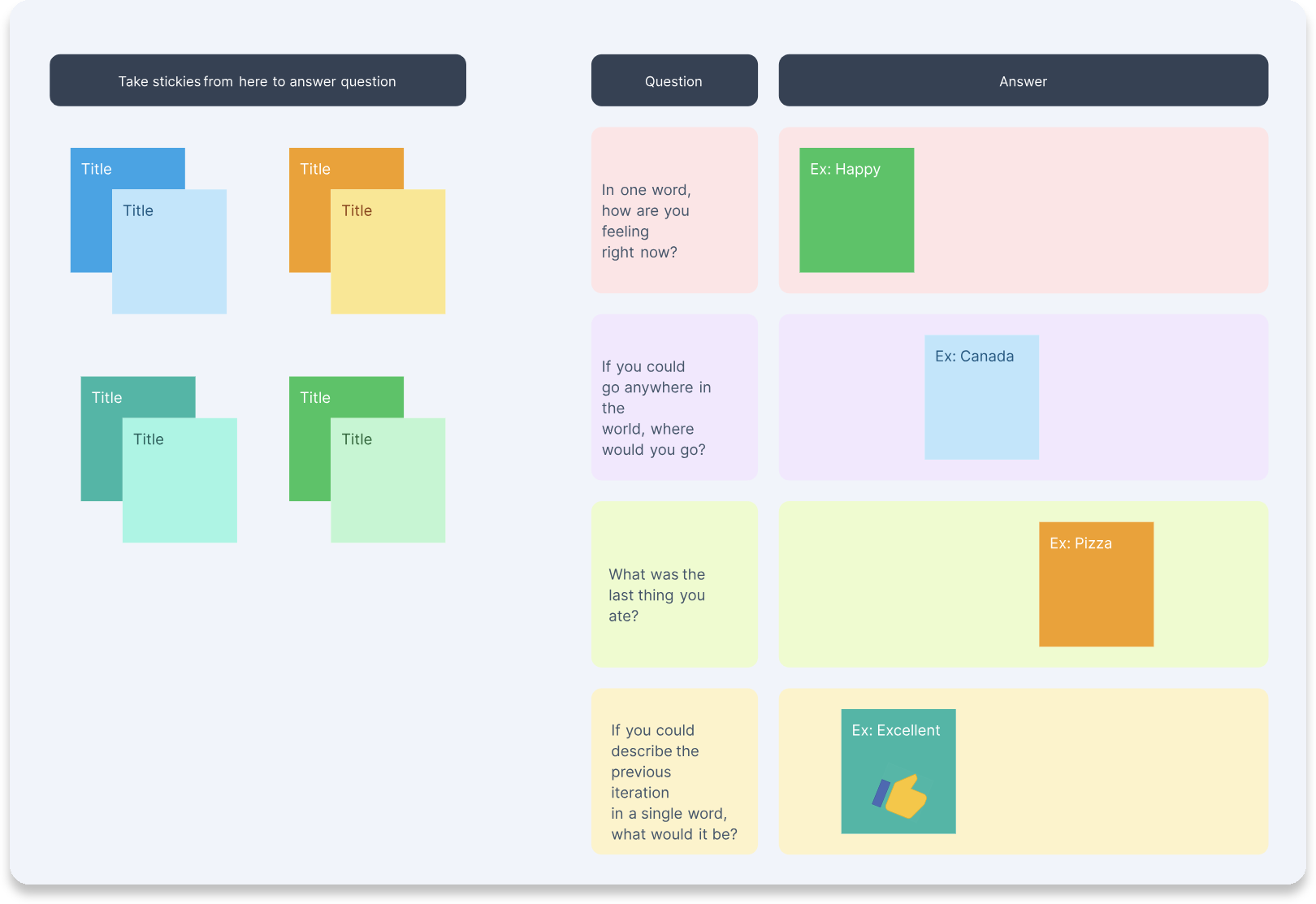
The first phase of a retrospective involves setting the stage and creating the right environment for open and constructive discussions. Here’s how to effectively set the stage: Kick off the retrospective with an icebreaker activity to engage participants and create a positive atmosphere. One effective icebreaker is to ask all participants to answer a question using just a single word or sentence.
By starting the retrospective with an icebreaker, you encourage active participation and help break the ice, setting a relaxed and collaborative tone for the rest of the session.
Define the purpose: Clearly communicate the purpose of the retrospective to the team. Whether it’s to improve a specific process, address challenges, or foster team collaboration, ensure that everyone understands the intended focus. This can be easily done on Creately’s visual canvas. Teams can huddle around a virtual workspace and conduct restros together. Before the team begins the retro you can clearly define the purpose of the particular retro workspace.

Establish ground rules: Set ground rules to guide the retrospective. These rules can include active listening, respecting different perspectives, and encouraging participation from all team members. You can also go over the mechanics of retro. The Creately retrospective template lists out the steps teams could take to conduct the retrospective. You can change, edit and customize these instructions to your team’s needs. So everybody gets a quick brief before the retro begins.
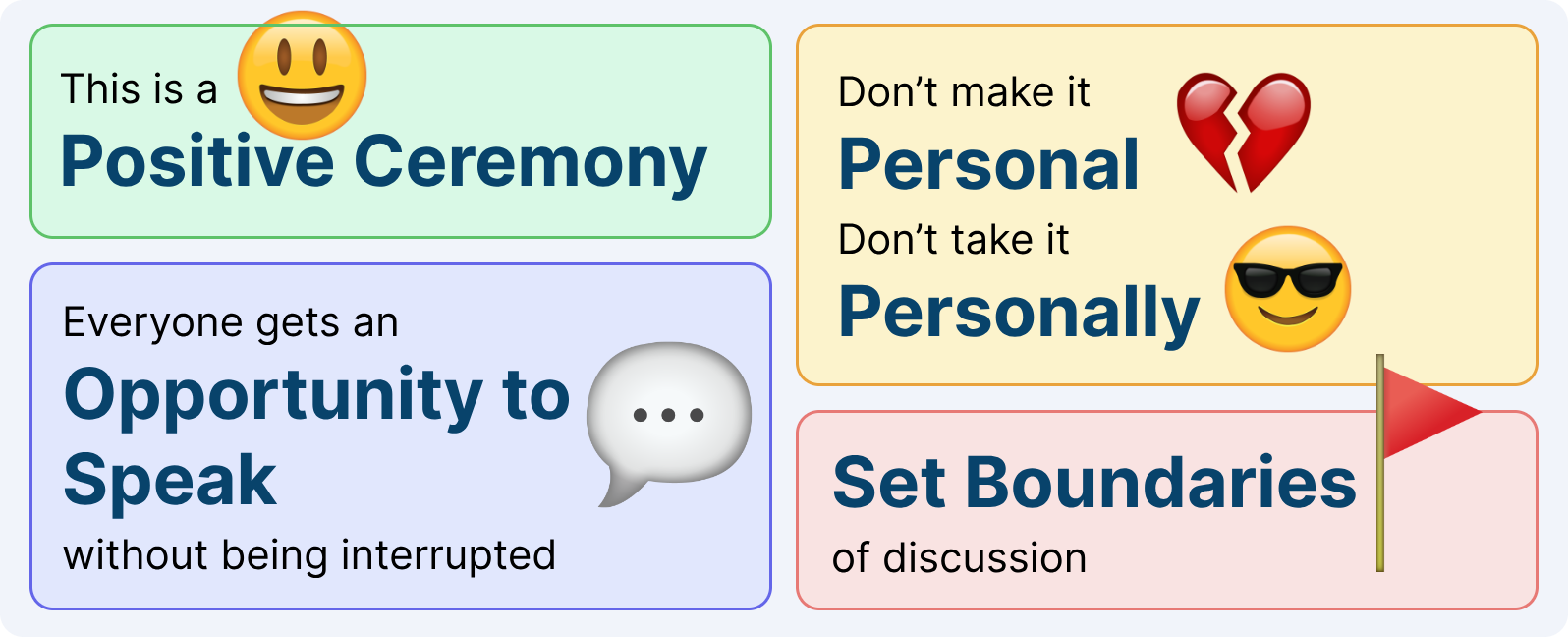
Create psychological safety: Emphasize the importance of psychological safety. Encourage a non-judgmental and inclusive atmosphere where everyone feels comfortable sharing their thoughts and ideas. A great way to do this is by re-stating the Prime Directive before the meeting starts. We found an effective way is to paste the prime directive right into the retro board, so everyone knows how to conduct themselves.
Introduce the agenda: Share the agenda and outline the different phases of the retrospective. This helps set expectations and provides a clear structure for the discussion.
Phase 2: Gathering data
Use data collection techniques: Start by employing various data collection techniques such as brainstorming, silent writing, or online surveys to gather individual perspectives. These techniques allow team members to reflect independently and share their insights. In Creately, teams can write things down on sticky notes on the canvas, which serves as a reflection and communication tool.
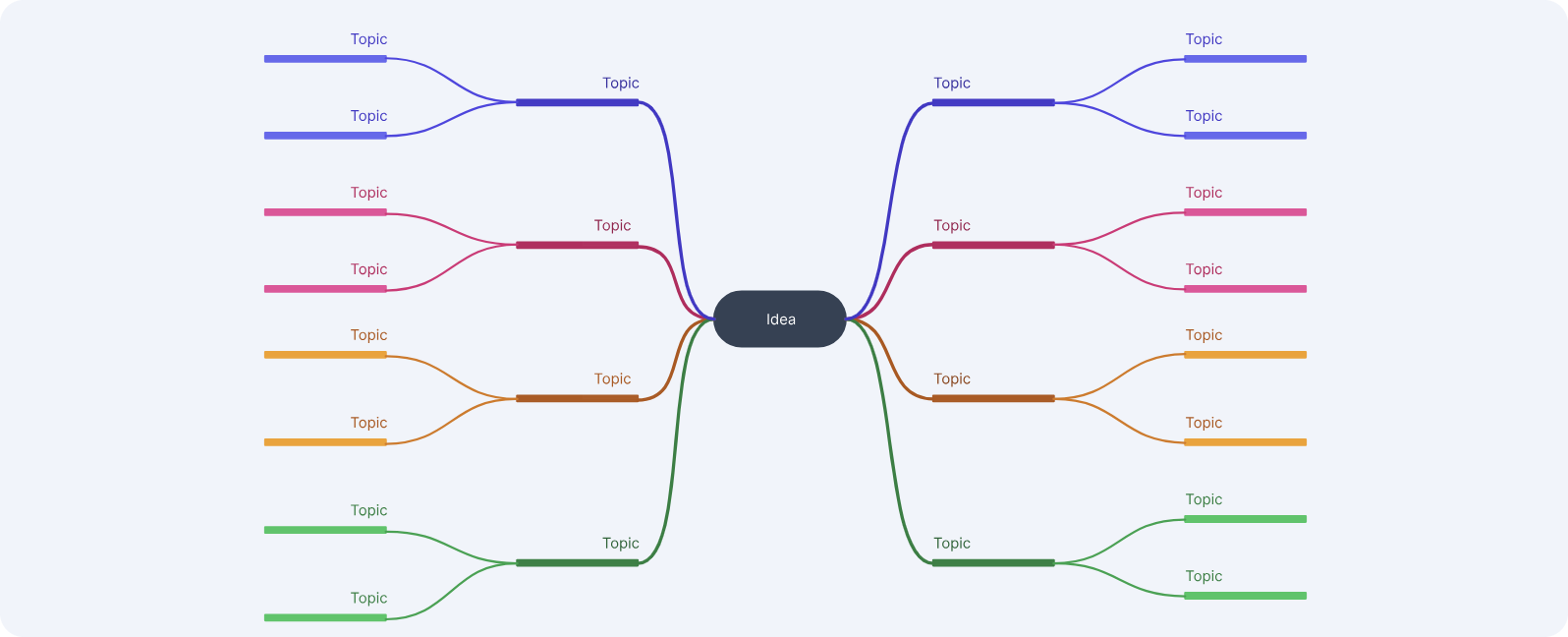
Collect observations: Encourage the team to share their observations and experiences related to the retrospective focus. This can include positive experiences, challenges faced, or any notable events that occurred during the project or sprint. Creately’s retrospective template provides columns where teams can group activities and organize their observations.
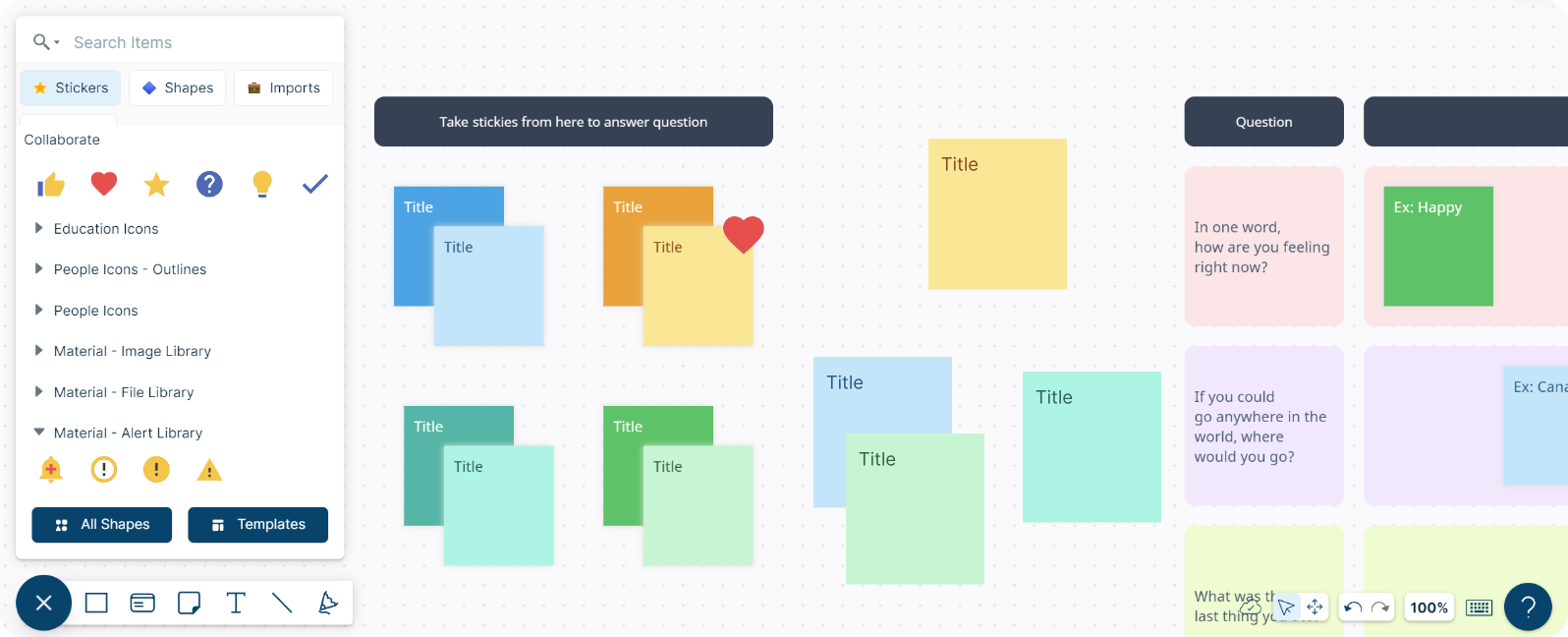
Capture metrics: In addition to qualitative data, it’s important to collect relevant metrics or data points that provide quantitative insights into the team’s performance. This can include cycle time, customer satisfaction scores, or any other metrics aligned with the retrospective’s objectives. Teams can attach notes, documents, or attachments to each sticky note in Creately, allowing them to provide detailed explanations or references to support the data and insights shared during the retrospective.
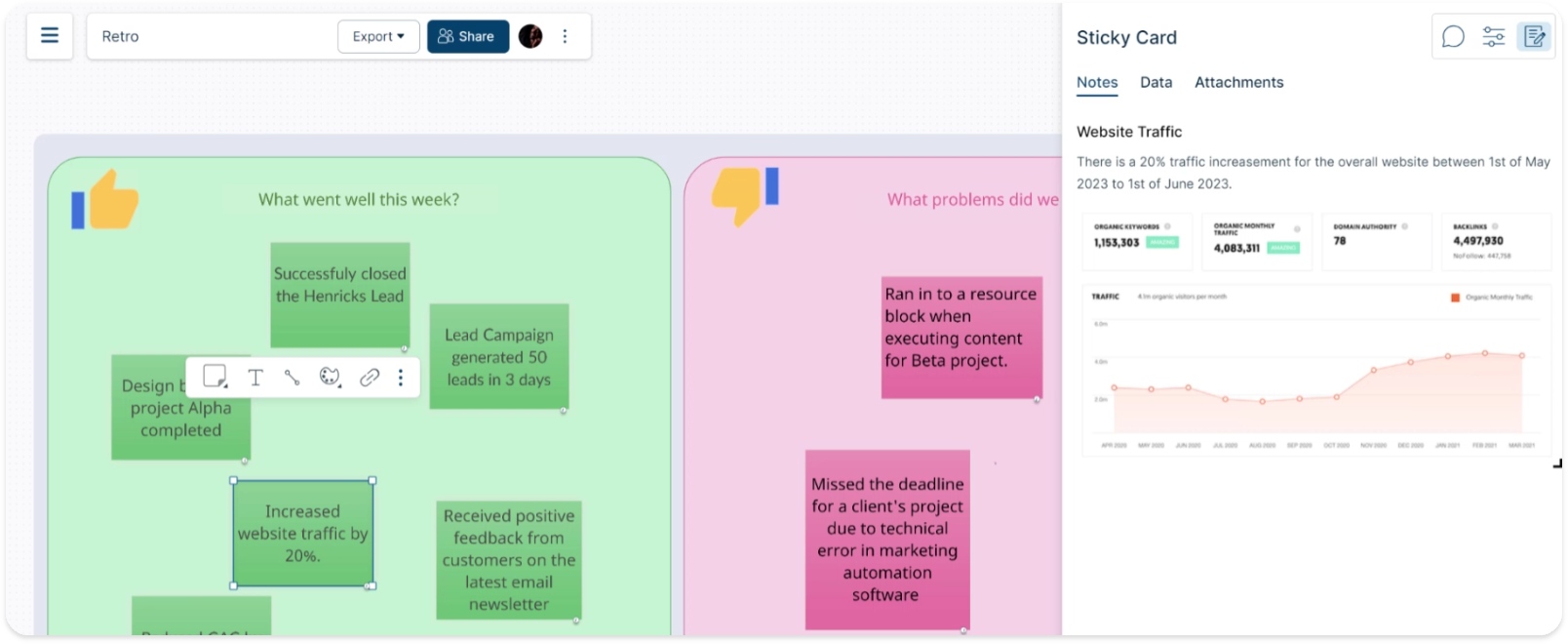
Creately enables teams to utilize its collaborative canvas, sticky note features, and retro template to efficiently collect and organize their reflections, ideas, and supporting materials. By leveraging these features, teams can foster effective communication, group activities, and attach relevant documentation, ensuring that valuable data is captured for further analysis.
Types of data to bring:
When it comes to gathering data for your retrospective, there are two types of information to consider: objective (or “hard”) data and subjective (or “soft”) data. Both types play a crucial role in gaining a comprehensive understanding of your team’s performance and experiences. Let’s explore these data types and how they contribute to a meaningful retrospective.
Objective data, often referred to as “hard data,” consists of measurable and verifiable information. It provides concrete facts and figures that can shed light on your team’s progress and performance. Here are some examples of objective data you can bring to your retrospective:
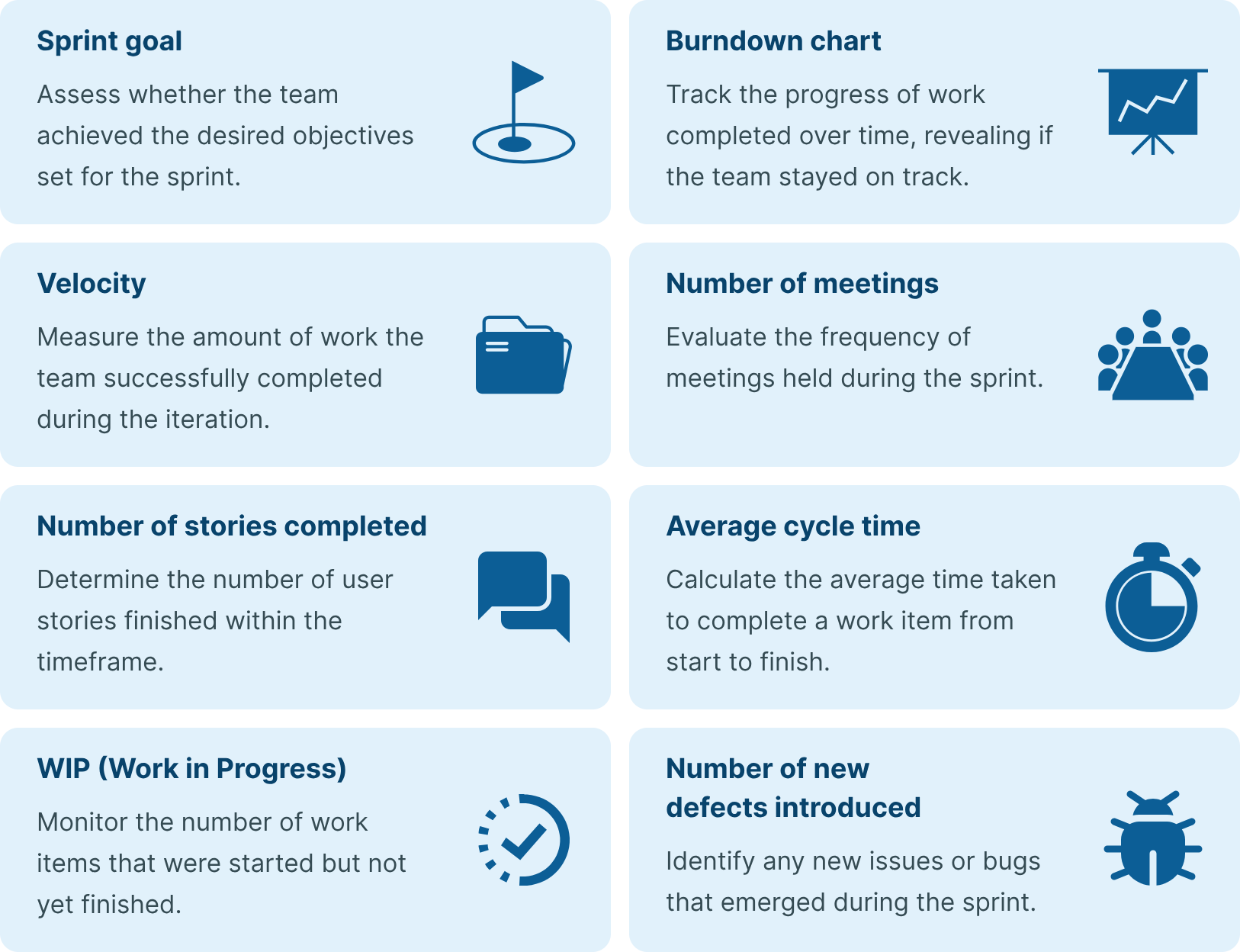
Remember, you don’t have to bring all of this data to every retrospective. Instead, consider the context and bring the data that would be most relevant and insightful given the current circumstances.
On the other hand, subjective data, also known as “soft data,” encompasses personal opinions, feelings, and emotions within the team. While objective data presents the facts, subjective data provides valuable insights into how your team perceives and experiences those facts. Here are some questions to gather subjective data:
When did you feel motivated or unmotivated during the sprint?
What was the best moment and the worst moment in the iteration?
How satisfied were you with the introduction of a new practice or process?
Subjective data provides a deeper understanding of team dynamics, individual experiences, and perceptions. It complements the objective data, offering valuable context and insights that contribute to a more holistic retrospective analysis.
During the Gather Data phase, Creately proves to be a valuable tool. Team members can use Creately’s collaborative canvas to write down their subjective reflections and attach sticky notes with their insights. Furthermore, they can organize the objective data by grouping activities into various columns of the retro template, facilitating effective reflection and communication.
Phase 3: Discovering Insights
This is where the true magic happens as teams come together to unravel hidden treasures of knowledge and gain a profound collective understanding. Retrospectives bring teams together and allow them to share perspectives, identify patterns, and gain a shared understanding of the events that transpired.
Step 1: Analyzing data and observations
During this step, the team analyzes the collected data, observations, and metrics to identify patterns, trends, and potential areas for improvement. Creately provides a visual canvas where team members can collaboratively organize and visualize the data using sticky notes, diagrams, or mind maps. With the ability to attach notes, documents, and other attachments to each sticky note, this keeps everything together so discussions are free-flowing and productive.
Step 2: Identifying root causes
In this step, the team delves deeper into the identified patterns and explores their root causes. You can load up fishbone diagrams or cause-and-effect diagrams on Creately that help team members visualize and analyze the underlying causes.
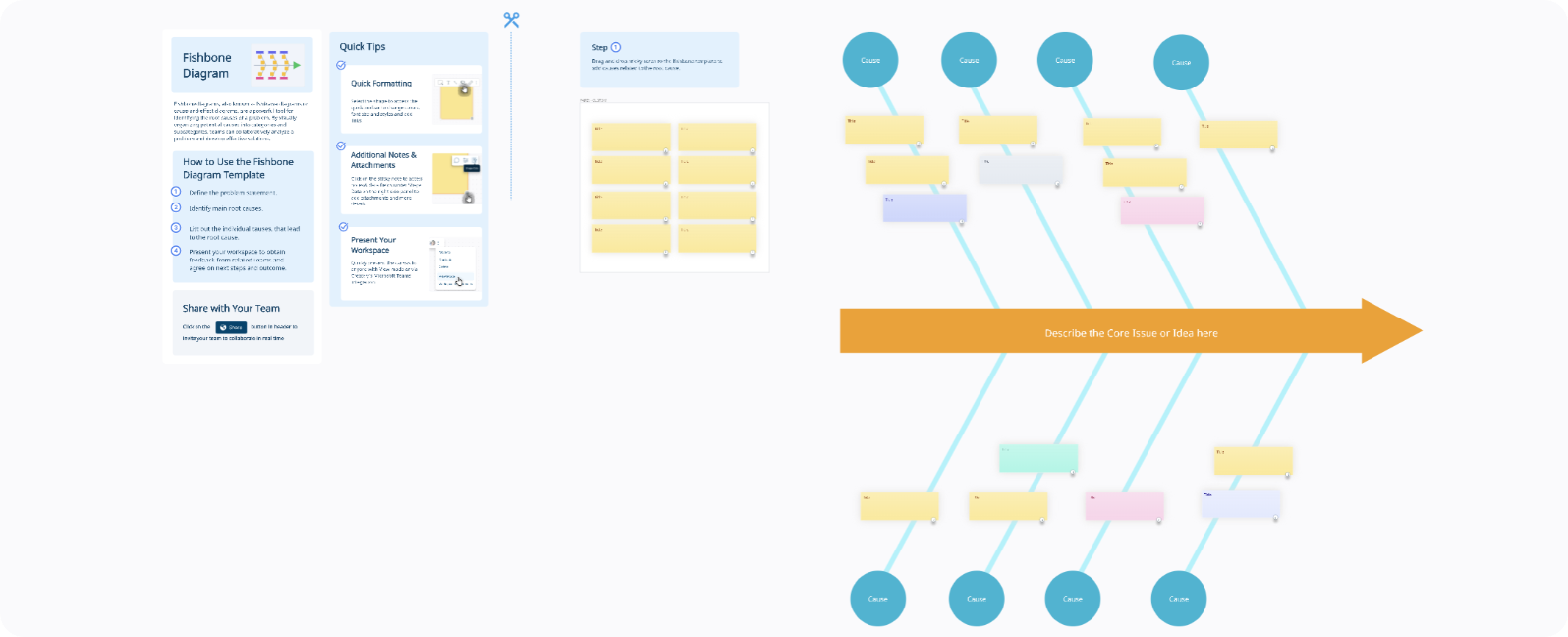
One of the easiest ways to understand the power of generating insights is by utilizing the 5 Whys activity. This facilitation technique, as simple as its name suggests, helps us discover the underlying causes of an issue.
A great way to do this is by breaking your group into smaller subgroups of 2-4 people. Encourage each subgroup to independently perform the 5 Whys exercise using Creately, and then have them report their findings back to the larger group. This approach not only fosters active participation but also encourages diverse perspectives and deepens the discovery process.
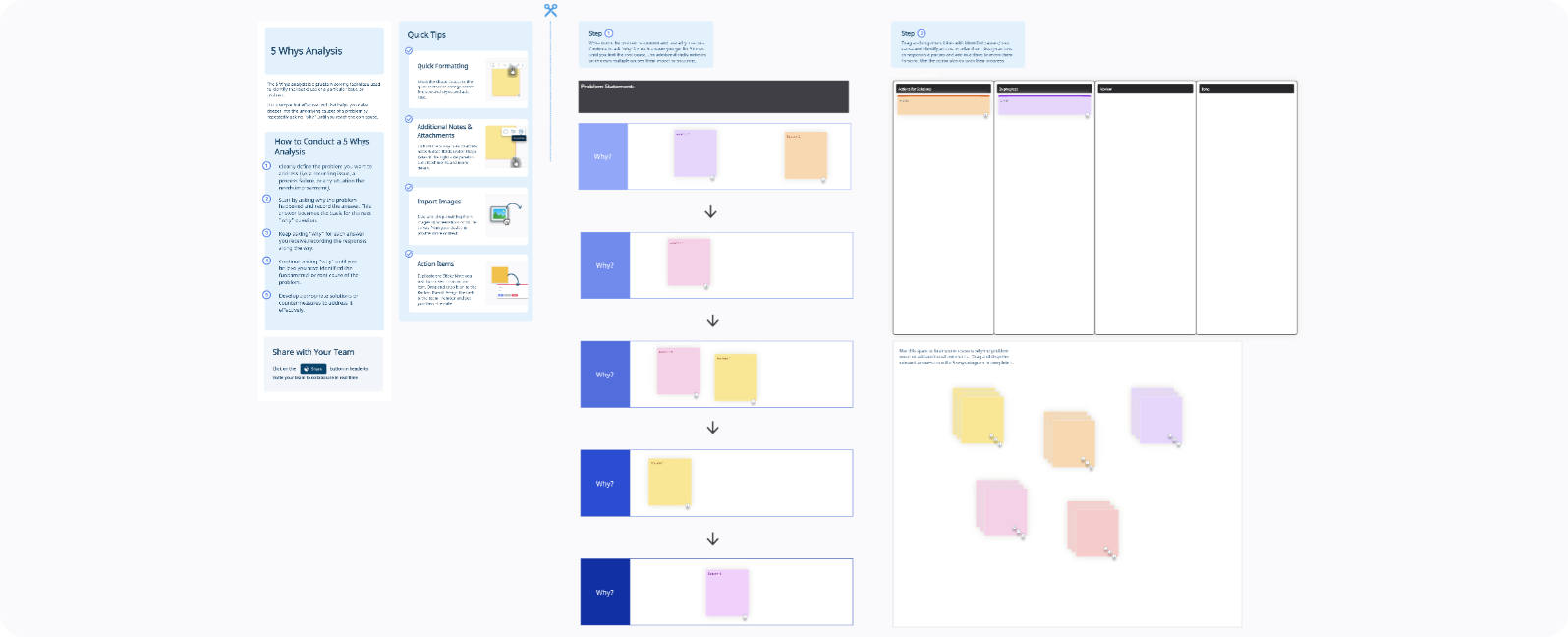
Force Field Analysis
Incorporating a force field analysis into the retro helps teams deepen their understanding of the current situation and help them plan for the future.
This problem-solving technique helps identify and assess the driving and restraining forces that impact a desired change or goal. It provides a visual framework for understanding the various factors that influence the success or failure of a proposed change.
Select a topic, issue, or proposed change that you want to examine closely and analyze.
Create two columns on a whiteboard: Supporting Factors and Restraining Factors.
Divide your group into smaller subgroups of 2-4 people, encouraging collaboration and diverse perspectives.
Within each subgroup, unleash the power of brainstorming to uncover all the factors that support the topic or drive the change forward. Then, select one influential factor from the list and place it under the Supporting Factors column on the whiteboard.
Repeat the process in step 4, but this time focus on the factors that oppose the topic or prohibit the change from occurring. Captivate the group’s attention as they uncover these restraining factors, placing them under the Restraining Factors column on the whiteboard.
Now, it’s time to harness the collective wisdom. Invite each person to cast their vote for the item they perceive as the strongest driving force and the most impactful restraining force.
Embark on an insightful analysis of the Supporting Factors, aiming to determine which ones the group can further strengthen to amplify the desired change.
Similarly, delve into the Restraining Factors, seeking to identify strategies and actions to lessen their impact and pave the way for progress.
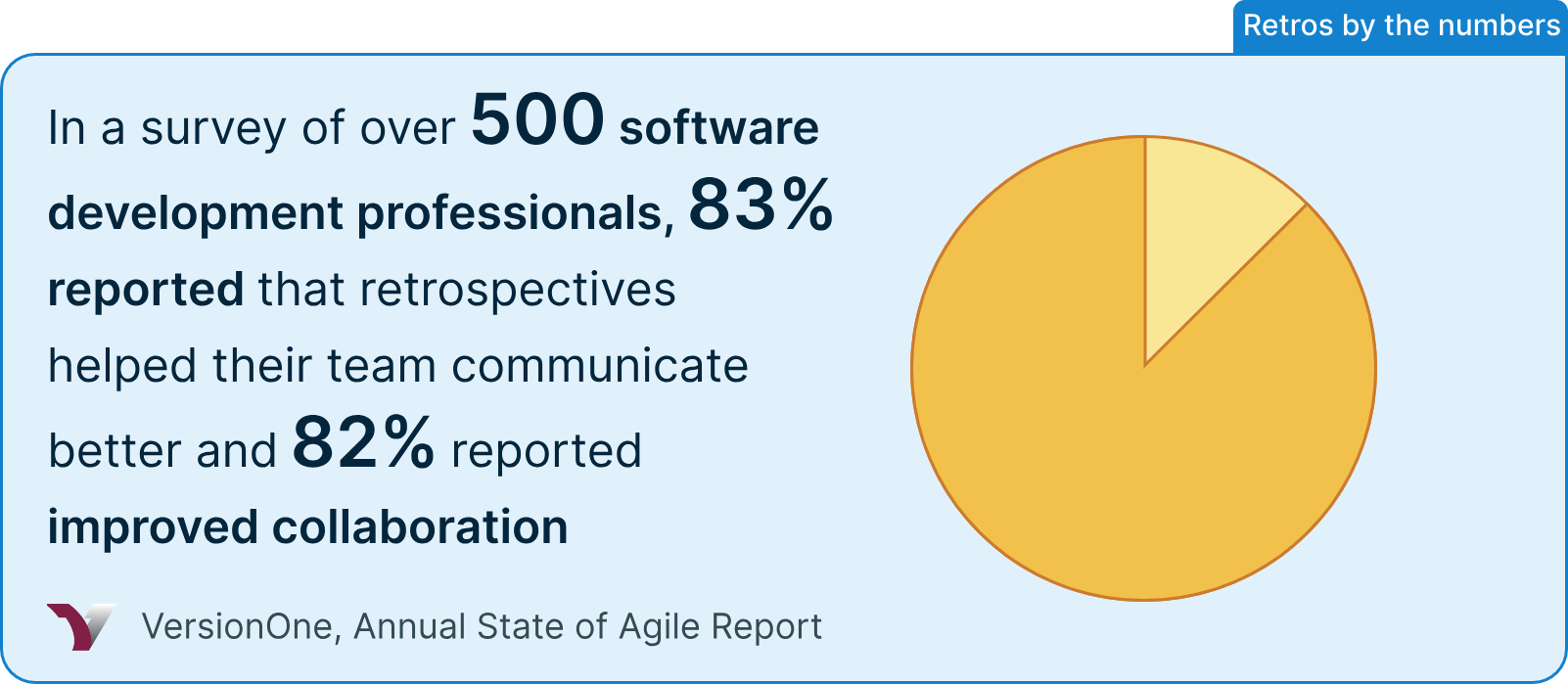
Phase 4: Decide
You’ve analyzed the issue, and now it’s time for action! This phase will energize your solution-focused team, as it’s all about fixing problems.The key here is selecting the best action for the upcoming iteration. It is important to establish that this is the whole point of the retrospective, and it isn’t just a venting session where teams can blow off some steam about the things that frustrate them.
A great way to pick the right thing to work on so that your team can see the benefits of the retrospective is by using the Start Stop Continue framework.
Using prioritization grids enables teams to come to a consensus on what the best course of action should be and where their energy could be best utilized.
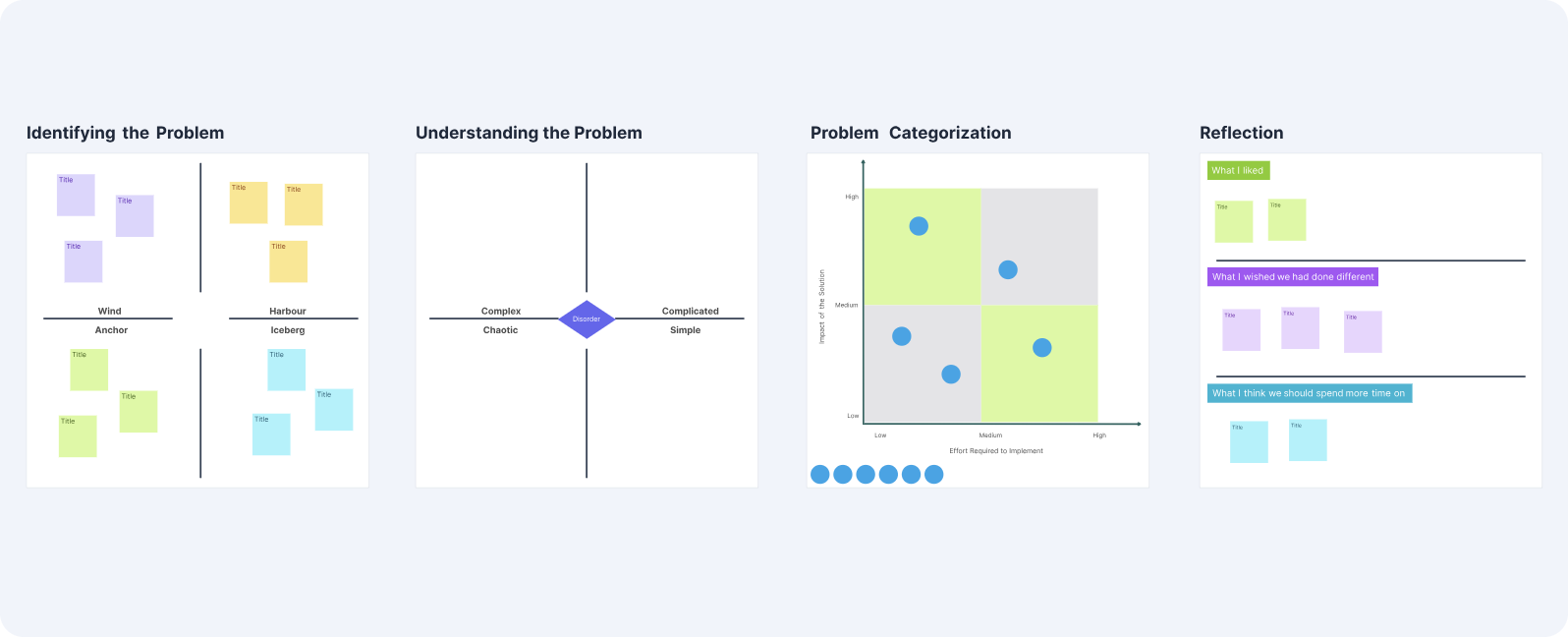
- It helps teams pick the change item with the highest impact and lowest amount of effort
- It builds momentum for the change to occur
- It established a common framework for picking a change item
Phase 5: Closing off
The “Closing Off” phase marks the conclusion of the retrospective and focuses on wrapping up the session in a meaningful and productive way. This phase provides an opportunity for the team to reflect on the retrospective process itself, celebrate achievements, and set the stage for future retrospectives.
Here are some essential steps to consider during the Closing Off phase:
Reflection and appreciation: Take a moment to reflect on the retrospective session as a whole. Encourage team members to share their thoughts and feelings about the process, highlighting what worked well and areas that could be improved. Express appreciation for the team’s active participation, openness, and commitment to continuous improvement.
Celebrate achievements: Acknowledge and celebrate any accomplishments, milestones, or positive changes that have occurred since the last retrospective. Recognize individual and collective efforts that have contributed to the team’s progress. Celebrating achievements helps boost morale and reinforces a culture of appreciation and success.
Action item review: Review the action items identified during the Decide phase. Verify that each action item is clearly documented, assigned to a responsible team member, and includes a defined timeline. Confirm that the action items align with the team’s goals and objectives. This step ensures that there is a clear plan for executing the agreed-upon improvements.
Follow-Up and accountability: Establish a system for follow-up and accountability to track the progress of the action items. Determine how and when progress will be reviewed and ensure that there is a mechanism in place to address any challenges or roadblocks that arise. Emphasize the importance of collective responsibility and encourage open communication to address any issues promptly.
Set the next retrospective date: Determine the date and time for the next retrospective session. This step ensures that the practice of reflection and continuous improvement remains ingrained in the team’s workflow. Consider establishing a regular cadence for retrospectives, such as after every sprint or at the end of each project phase.
Provide closure and appreciation: Conclude the retrospective on a positive note by expressing gratitude and appreciation for the team’s active participation, insights, and contributions. Reinforce the value of the retrospective process as a means for growth, collaboration, and learning. Encourage team members to carry the retrospective mindset forward into their daily work
How not to run A retrospective
Running a retrospective effectively requires careful planning and execution. To ensure a successful retrospective, it is important to avoid common pitfalls that can hinder its effectiveness. Here are some things to avoid:
Lack of preparation: Failing to prepare adequately can lead to unproductive retrospectives. Ensure that you have a clear understanding of the retrospective’s purpose, goals, and desired outcomes. Prepare any necessary materials, such as templates or facilitation tools.
Ignoring psychological safety: Psychological safety is crucial for a successful retrospective. Create an environment where team members feel comfortable expressing their thoughts, opinions, and concerns without fear of judgment or repercussions. Encourage open and honest communication.
Dominating the discussion: As a facilitator, it’s important to avoid dominating the discussion. Your role is to guide the retrospective and ensure equal participation from all team members. Encourage everyone to share their insights and actively listen to their contributions.
Focusing solely on problems: While it’s important to identify and address challenges, retrospectives should also highlight successes and areas of improvement. Balance the discussion by recognizing achievements and exploring opportunities for growth.
Chapter 4: Building Rituals
Retrospectives are how you build the culture of your team. The act of reflecting back on action and acknowledging how a team functions bleeds into all other aspects of how a team works together. The better your retrospectives get, the more involved and participative teams become. This creates a sense of connection; suddenly they are no longer colleagues working on a project together but are actively solving problems as one engaged and involved unit.
Getting here is all about building the right rituals.
Let’s delve into the key elements to build lasting and impactful rituals
Establishing group norms:
These are a set of agreed-upon rules and principles that guide the behavior and interactions within the team. They include the small things around what to expect during this meeting, removing the uncertainty helps people approach this meeting much more openly. As you go on, remember to develop and explicitly communicate what the norms are. The more these get embedded into the fabric of your retros the better your chances of creating free and open discussions. By collectively defining how team members communicate, share ideas, and provide feedback, you create a safe and respectful environment for open discussions. Many times this affects the entire culture of the organization.
Discussion at every phase
To ensure that retrospectives are meaningful, discussions should be encouraged at every phase of the process. From setting the stage and gathering data to generating insights and deciding on actionable improvements, involving all team members fosters a sense of ownership and inclusivity. By creating an environment where everyone feels comfortable sharing their perspectives, you unlock a wealth of insights that can drive positive change. The constant re-iteration of discussion ensures that all voices are heard and valuable contributions are made throughout the project lifecycle.
Create your rules to live by
While it’s essential to establish group norms, it’s equally important to create your own rules to live by during retrospectives. These rules should reflect the specific needs and dynamics of your team. For example, you might adopt the “No Blame” rule, which encourages focusing on finding solutions rather than assigning blame or “Embrace Diverse Ideas”- this rule encourages team members to contribute their thoughts, irrespective of how unconventional they may seem. By setting these rules, you provide a clear framework for effective collaboration and constructive discussions.
Common mistakes to avoid:
To make the most out of your retrospective rituals, it’s crucial to steer clear of common pitfalls. One common mistake is focusing solely on problems and failures, neglecting the opportunity to celebrate successes and identify what’s working well. Remember to maintain a balanced approach by acknowledging achievements and extracting valuable insights from both positive and negative experiences.
Focus on the small wins:
While it’s important to address areas for improvement, don’t underestimate the power of focusing on the small wins. Celebrating even the smallest victories can boost team morale and motivation. Recognizing and appreciating the efforts and accomplishments, no matter how minor ,instills a sense of progress and encourages continuous improvement. By highlighting the small wins, you create a positive and uplifting atmosphere during retrospectives.
10 Ideas to increase engagement
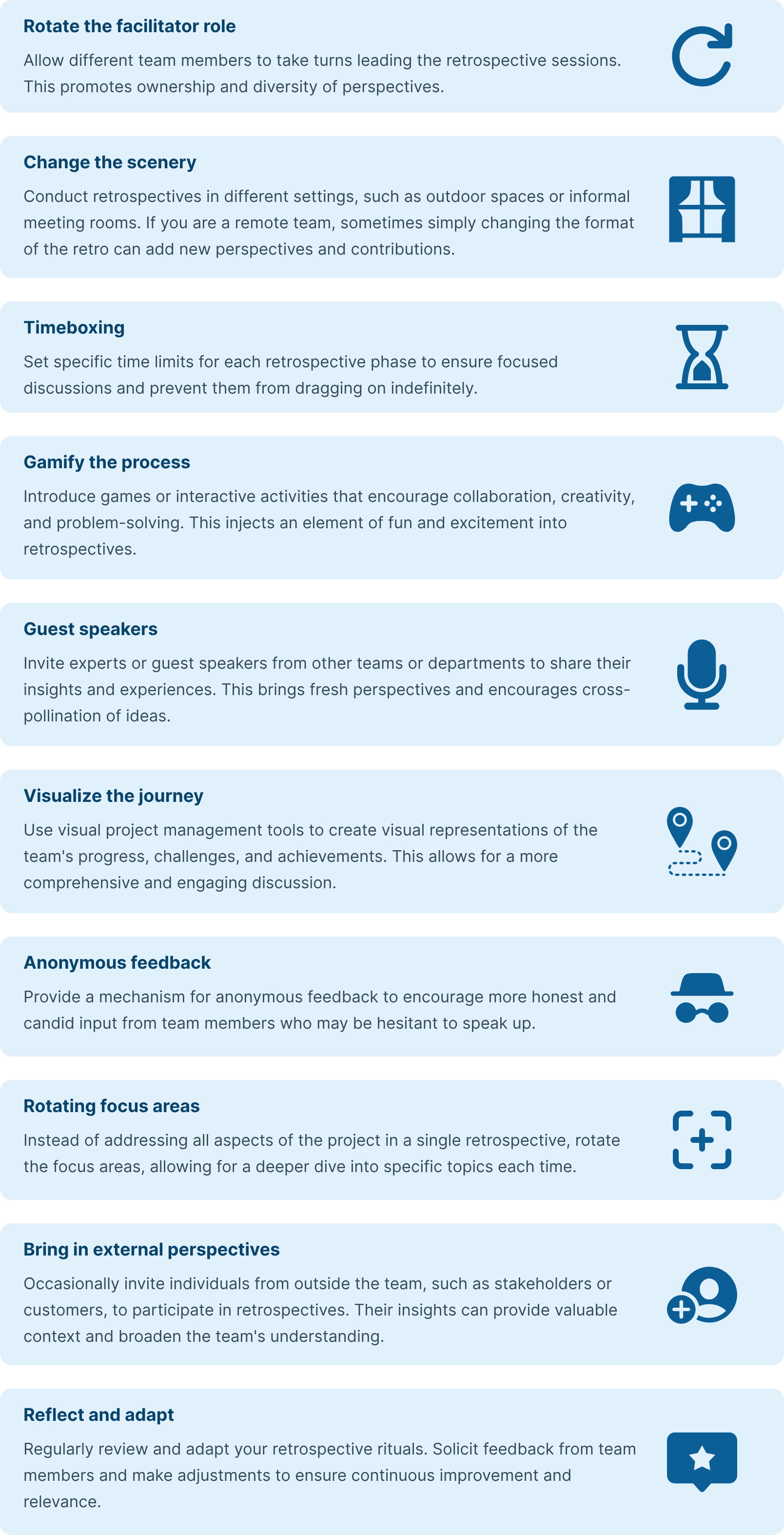
Chapter 5: Data Over Feelings
During retros, a lot of thoughts, opinions, and feelings are shared. This is great for the culture of the team, but to make informed decisions and drive meaningful change, it is crucial to establish data as the central point of focus. This chapter will explore the importance of prioritizing data in retrospectives and how it can be developed as a skill. By emphasizing the use of data, teams can enhance their decision-making process, promote objective analysis, and foster a culture of continuous improvement.
Context is everything
To leverage the power of data in retrospectives truly, it is essential to understand the context in which it is collected. Data without proper context may lead to misinterpretations and misguided conclusions. For example, let’s consider a team that experienced a significant drop in productivity during a sprint. Without understanding the external factors, such as increased customer requests or technical challenges, the data alone may suggest a decline in the team performance. By providing the necessary context, the team can analyze the data more accurately and identify the underlying causes. Having precise data, exactly when you need it adds a different dimension to the retro, it takes away the abstractions and allows teams to have much more nuanced discussions. When running a retro on Creately you can add specific data items to any object on the canvas, so when a team member wants to discuss a particular point the entire team can have access to all the relevant information.
Keeping everything together
To maximize the utilization of data in retrospectives, it is crucial to have all project information readily accessible in one place. With visual collaborative tools like Creately, teams can gather and organize essential data points, enabling cross-functional teams to have a comprehensive view of the project’s progress and performance.
Creately serves as a dynamic retro board that acts as a living reference for the team. It allows you to pin wikis, timelines, briefs, and other relevant documents directly onto the board. This eliminates the need for team members to share their screens or interrupt the flow of the retro by searching for information. Everything is conveniently located in one central space, enhancing the efficiency and effectiveness of the retrospective process.
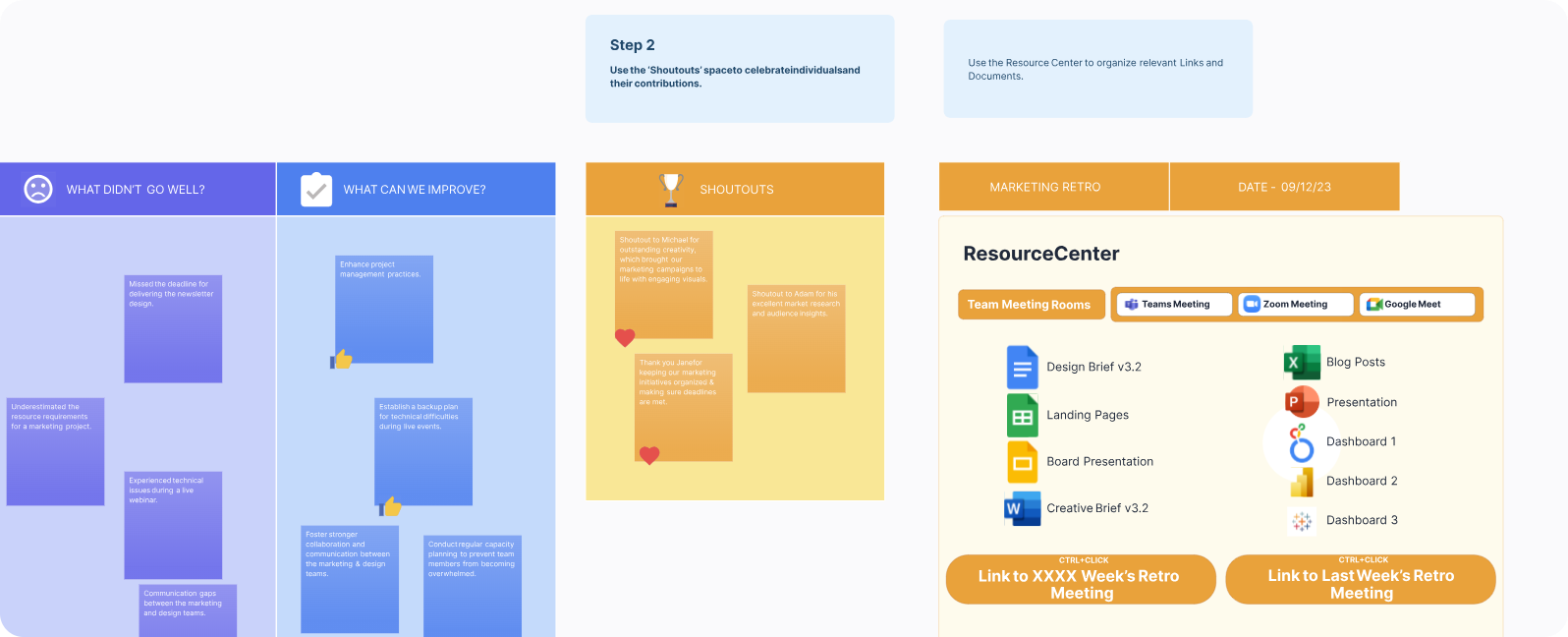
Furthermore, Creately enables the inclusion of links within the retro board, providing seamless integration of external documents and online resources. Team members can easily access additional insights, references, or supporting data without navigating away from the retro board. This integrated approach ensures that all necessary information is available at the team’s fingertips, promoting collaborative discussions and informed decision-making.
By utilizing a visual collaborative tool like Creately, teams can streamline their retrospectives by keeping all project information together in one accessible location. This centralized data access Retrospectives are not casual discussions around subjective opinions; they are data-driven sessions that rely on concrete information and insights. By collecting and analyzing relevant data, teams can gain a comprehensive understanding of their past performance, identify patterns, and make informed decisions for future improvements. Understanding how to collect and present the right data is an essential part of the continuous improvement cycle
saves time, eliminates disruptions, and empowers teams to make data-driven decisions during retrospectives.
The importance of hard data and soft data
Having both hard and soft data during retrospectives offers several benefits. Hard data provides objective and quantifiable metrics for performance analysis, while soft data offers subjective insights and observations about team dynamics and experiences. This combination enables more informed and balanced decision-making, leading to effective process improvements and fostering empathy within the team.
Connecting retrospectives
Retrospectives should not be viewed as isolated events but rather as part of an ongoing learning cycle. Each retrospective should build upon the knowledge and outcomes of previous retrospectives. By establishing a connection between retrospectives, teams can identify trends, patterns, and recurring issues. Visual collaborative tools like Creately enable teams to create visual representations that link retrospectives together, forming a cohesive timeline of actions, outcomes, and learnings. This visualization aids in tracking progress, evaluating the effectiveness of past actions, and making informed decisions based on historical data.
Best ways to use data (and not be bogged down by It)
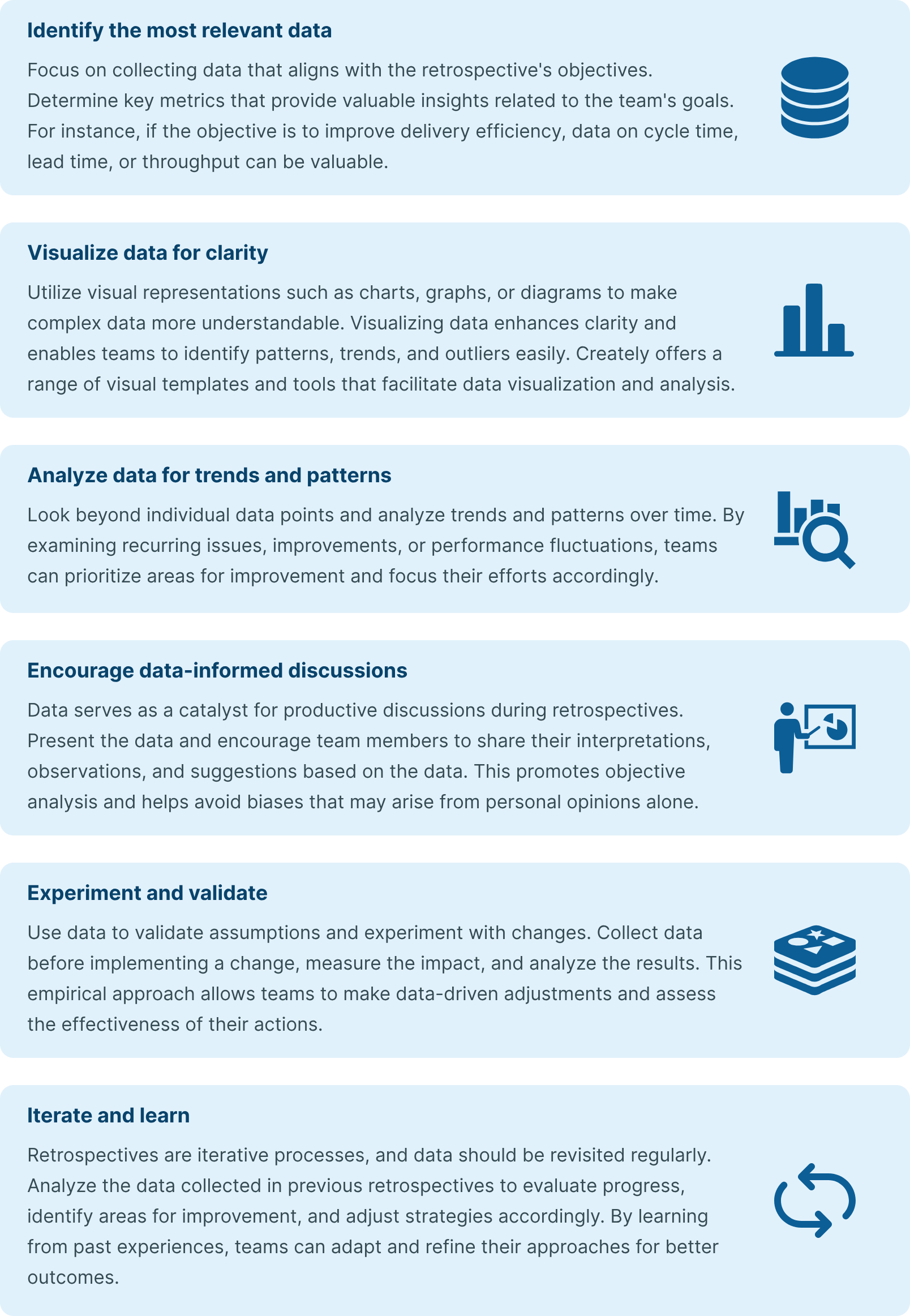
With data as the foundation, teams can unlock their full potential and achieve greater success in their agile journey.

Chapter 6: Making Sure Retros Lead to Action
Now that the retro is over, it’s time to shift our focus towards the most crucial aspect of retrospectives: implementing meaningful improvements based on the valuable insights we have gained. And yes, we know, that can be hard. Too often teams are stuck in the ‘what happens in the retro, stays in the retro cycle’. But here’s the good news: by following a simple three-step process, we can significantly increase the odds of driving genuine improvements from our retrospectives. In this chapter, we will explore this process in detail, empowering you and your team to make the most of your retrospective findings and pave the way for positive change.
No, it’s not all fun and games
It’s not uncommon to see teams prioritize fun and enjoyment during retrospectives. A quick search online reveals a significant focus on “fun retrospectives” compared to “Retrospective Action Items.” While it’s important to have an enjoyable experience, we must not let fun overshadow the primary goal of driving improvement. Merely having fun without genuine change leads to wasted opportunities and hinders team growth.
Choosing the right action items
One common mistake teams make is rushing to agree on an Action Item without thorough consideration. To choose the right action, it’s crucial to follow a process that allows for effective brainstorming and careful evaluation. Teams should engage in a diverge and converge pattern, where they explore various potential Action Items before narrowing down the most promising ones. This process ensures a comprehensive understanding of the impediments and allows for the best possible solutions to emerge.
To evaluate Action Items effectively, we can utilize the RICE matrix. The RICE matrix incorporates factors such as Reach, Impact, Confidence, and Effort to prioritize and select the most promising Action Items. By assigning scores to these factors and calculating the RICE score for each option, we can make informed decisions and choose the Action Item that offers the highest potential for positive change.
For example, let’s consider two candidate Action Items: improving communication within the team and implementing a new testing framework. Using the RICE matrix, we can assess each item based on its potential Reach (the number of team members affected), Impact (the expected improvement), Confidence (the certainty of achieving the improvement), and Effort (the resources and time required). By assigning scores to these factors and calculating the RICE score, we can determine which Action Item to pursue.

Clarifying action items
Once we have chosen the right Action Item, it’s crucial to write it down deliberately to ensure clarity and accountability. This is where the SMART approach comes in handy. SMART stands for Specific, Measurable, Attainable, Relevant, and Time-Based. By applying these criteria to our Action Items, we increase the likelihood of successful implementation. For instance, instead of a vague Action Item like “Improve communication,” we can rewrite it using the SMART criteria: “Implement a daily stand-up meeting to enhance communication within the team by the end of this sprint.”
Discuss Progress Regularly
Creating Action Items is only the beginning. To drive real change, it’s essential to discuss progress frequently and hold team members accountable. Regular progress discussions help ensure that the Action Items are being implemented as planned and any obstacles are addressed promptly. It’s crucial to set deadlines for Action Items to establish a timeline for implementation. Surprisingly, a survey found that only 12% of respondents always assign deadlines to their Action Items. This statistic highlights the need for improvement in this area.
Go forth and retro Remember, retrospectives are not just a meeting, a report, or a postmortem—they are living, breathing processes that connect past experience with future action.
So, as you embark on your retrospective adventures, armed with the knowledge and strategies we’ve shared, go forth and create a culture of continuous improvement. Harness the power of data, embrace open discussions, and celebrate the growth and achievements along the way. Remember, it’s the small steps, the incremental changes, and the collective efforts that pave the way for remarkable success.
Thank you for joining us on this retrospective ride. For more guides, resources, and tools to conduct retrospectives check out our other guides and resources.






